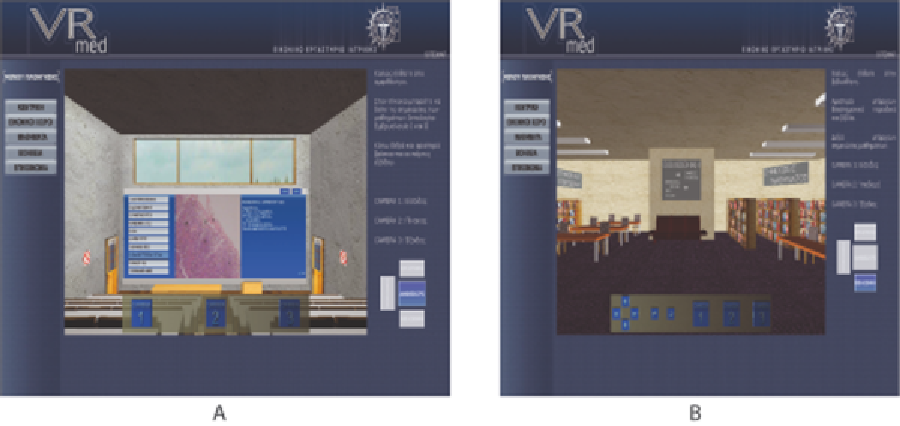Graphics Programs Reference
In-Depth Information
Figure 6. (a) The virtual classroom and (b) the virtual library
tion to critical information, which is transferred
from the short term to the long term memory ac-
cording to the cognitivism theory. Moreover, all
virtual worlds have been designed and developed
in such a way in order to encourage searching of
knowledge and incorporate constructivist features,
which contribute to the active participation of
students and the acquisition of knowledge through
their interaction with the virtual worlds.
The architectural structure of the virtual en-
vironment is divided in two parts: the physical
learning environment and the simulation of the
application. The physical learning environment
consists of a number of virtual worlds that re-
produce conditions of the real learning process
in a physical educational environment, while the
primary goal of the medical simulation is to en-
hance learning. Students visit each virtual world
searching for knowledge and they participate in
different learning processes. The designing of the
virtual worlds is focused on three main features:
navigation, interaction and presence. In particular,
special care was given to the development of a
user friendly navigation system, which allows even
non-familiar users to easily navigate within the
virtual worlds (the navigation system is always
visible at the bottom of each virtual world). On
the other hand, for the easy access of students
to the educational material and the avoidance
of users' disorientation problems, special signs,
voice messages, navigation maps, as well as
functions allowing the direct transition of users
to predefined positions were used. Furthermore,
multiple interactive functionalities are supported
both by the physical learning environment (e.g.
interactive boards) and the simulation of the ap-
plication (e.g. deformation of hepatic cells, change
of the cell's transparency etc). Finally, the feeling
of presence in the virtual worlds was supported
by the use of textures, lights, sounds and detailed
3D modeling in order to enhance the realism of
the virtual environment.
Specifically, the virtual environment consists
of the following virtual worlds:
•
Entrance:
The role of the entrance is
mainly to enhance the feeling of presence
within the virtual environment and transfer
students to a familiar place, which is a part
of previous knowledge and makes them

Search WWH ::

Custom Search